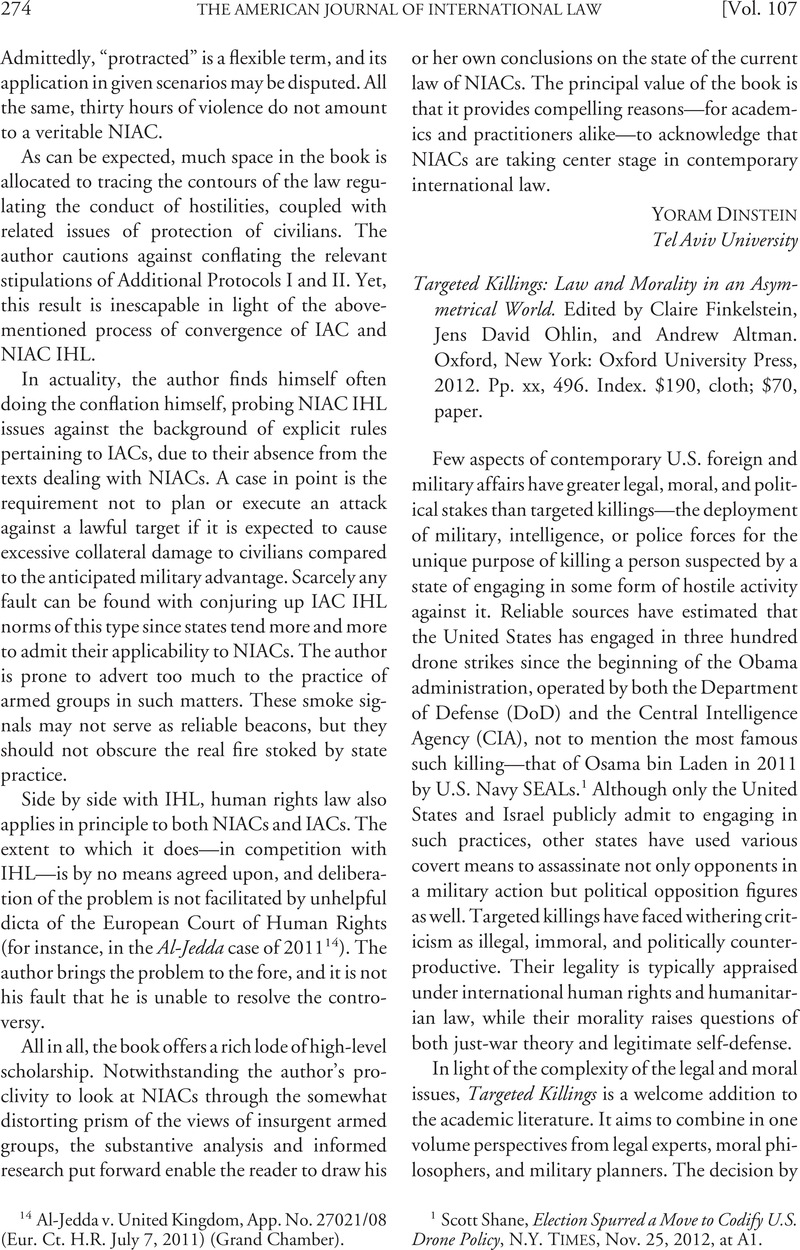Article contents
Targeted Killings: Law and Morality in an Asymmetrical World. Edited by Claire Finkelstein, Jens David Ohlin, and Andrew Altman. Oxford, New York: Oxford University Press, 2012. Pp. xx, 496. Index. $190, cloth; $70, paper.
Published online by Cambridge University Press: 20 January 2017
Abstract

- Type
- Recent Books on International Law
- Information
- Copyright
- Copyright © American Society of International Law 2013
References
1 Scott Shane, Election Spurred a Move to Codify U.S. Drone Policy, N.Y. Times, Nov. 25, 2012, at A1.
2 For one such effort, see Hakimi, Monica, A Functional Approach to Targeting and Detention, 110 Mich. L. Rev. 1365 (2012)Google Scholar.
3 See HCJ 769/02 Pub. Comm. Against Torture in Israel v. Gov’t of Israel (Targeted Killing case), [2006] (2) Isr. L. Rep. 459.
4 Quoted in Shane, supra note 1.
5 For other views like mine, see, for example, The Leiden Policy Recommendations on Counter-Terrorism and International Law, para. 38, Appendix to Counter-Terrorism Strategies In A Fragmented International Legal Order: Meeting The Challenges (Larissa van den Herik & Nico Schrijver eds., forthcoming 2013); Tams, Christian J., The Use of Force Against Terrorists, 20 EUR. J. Int’l L. 359 (2009)CrossRefGoogle Scholar.
6 Thus, Meyer argues that a “proper” war requires a declaration of war (pp. 205–06), whereas both jus ad bellum and the Geneva Conventions make clear that such a declaration is not needed to trigger either set of norms. and Finkelstein states that it is a violation of IHL “to kill an enemy combatant if the soldier is aware of a substantial risk he will kill a non-combatant civilian in the process” (p. 177), which is also incorrect. See Protocol Additional to the Geneva Conventions of 12 August 1949, and Relating to the Protection of Victims of International Armed Conflicts, Art. 51(5)(b), June 8, 1977, 1125 UNTS 3 (banning indiscriminate attacks, defined to include “an attack which may be expected to cause incidental loss of civilian life, injury to civilians, damage to civilian objects, or a combination thereof, which would be excessive in relation to the concrete and direct military advantage anticipated”).
7 See Ratner, Steven R., Ethics and International Law: Integrating the Global Justice Project(s), 5 Int’l Theory (forthcoming 2013)Google Scholar.
- 1
- Cited by


